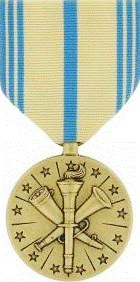
The Bronze Star Medal (BSM) is a United States Armed Forces decoration awarded to members of the United States Armed Forces for either heroic achievement, heroic service, meritorious achievement, or meritorious service in a combat zone.

The Legion of Merit (LOM) is a military award of the United States Armed Forces that is given for exceptionally meritorious conduct in the performance of outstanding services and achievements. The decoration is issued to members of the eight uniformed services of the United States as well as to military and political figures of foreign governments.
The Commendation Medal is a mid-level United States military decoration presented for sustained acts of heroism or meritorious service. Each branch of the United States Armed Forces issues its own version of the Commendation Medal, with a fifth version existing for acts of joint military service performed under the Department of Defense.

The Defense Superior Service Medal (DSSM) is a military decoration of the United States Department of Defense, which is presented to United States Armed Forces service members who perform superior meritorious service in a position of significant responsibility.

The Air Medal (AM) is a military decoration of the United States Armed Forces. It was created in 1942 and is awarded for single acts of heroism or meritorious achievement while participating in aerial flight.
The Achievement Medal is a military decoration of the United States Armed Forces. The Achievement Medal was first proposed as a means to recognize outstanding achievement or meritorious service of military personnel who were not eligible to receive the higher Commendation Medal or the Meritorious Service Medal.
A Sea Service Ribbon is an award of the United States Navy, U.S. Marine Corps, U.S. Coast Guard, the U.S. Army, and the NOAA Commissioned Officer Corps which recognizes those service members who have performed military duty while stationed on a United States Navy, Coast Guard, Army, or NOAA vessel at sea and/or members of the Navy, Marine Corps or Coast Guard who have been forward-deployed with their home unit.

An oak leaf cluster is a ribbon device to denote preceding decorations and awards consisting of a miniature bronze or silver twig of four oak leaves with three acorns on the stem. It is authorized by the United States Armed Forces for a specific set of decorations and awards of the Department of Defense, Department of the Army, and Department of the Air Force.
The Vietnam Service Medal is a military award of the United States Armed Forces established on 8 July 1965 by order of President Lyndon B. Johnson. The medal is awarded to recognize service during the Vietnam War by all members of the U.S. Armed Forces provided they meet the award requirements.
A "V" device is a metal 1⁄4-inch (6.4 mm) capital letter "V" with serifs which, when worn on certain decorations awarded by the United States Armed Forces, distinguishes a decoration awarded for combat valor or heroism from the same decoration being awarded for a member's actions under circumstances other than combat.
An Arabic numeral device or numeral device sometimes called an "award numeral", is a United States Armed Forces service device that may be authorized for wear on specific service ribbons and suspension ribbons of medals. Arabic numeral devices are bronze or gold in color and are 3⁄16 inch in height.

The Fleet Marine Force Combat Operation Insignia is a miniature 5⁄16 inch bronze United States Marine Corps emblem that may be authorized by the Secretary of the Navy for wear on specific campaign, expeditionary, and service medal ribbons issued to United States Navy sailors attached to and on duty with Fleet Marine Force (FMF) units during combat operations and sailors on duty with Navy units attached to and operating with Fleet Marine Force units while under Marine Corps operational control during combat operations. The device was instituted in 1953 with the Navy and Marine Corps Award Manual dated 1953.
The Citation Star was a Department of War personal valor decoration issued as a ribbon device which was first established by the United States Congress on July 9, 1918. When awarded, a 3⁄16-inch (4.8 mm) silver star was placed on the suspension ribbon and service ribbon of the World War I Victory Medal to denote a Citation (certificate) for "Gallantry In Action" was awarded to a soldier, or to a marine or attached to the Army's Second Division, American Expeditionary Forces. The Citation Star was replaced in 1932 with the introduction of the Silver Star Medal.

The Afghanistan Campaign Medal (ACM) is a military award of the United States Armed Forces which was created by Executive Order 13363 of President George W. Bush on November 29, 2004, and became available for general distribution in June 2005. The medal was designed by the U.S. Army Institute of Heraldry.
The Global War on Terrorism Expeditionary Medal (GWOT-EM) is a United States Armed Forces award created by George W. Bush on 12 March 2003, through Executive Order 13289. The medal recognizes those military service members who have deployed overseas in direct service to the War on Terror from 11 September 2001 to a date to be determined. Prior to 30 April 2005, the medal was awarded for service within Iraq and Afghanistan, but has been replaced with the Iraq Campaign Medal and Afghanistan Campaign Medal and serves primarily as recognition for personnel who have deployed in support of the War on Terror to locations beyond Iraq and Afghanistan. In a similar fashion the Inherent Resolve Campaign Medal is issued for service in the fight against ISIS, with eligibility retroactive to 15 June 2014.
The European–African–Middle Eastern Campaign Medal is a military award of the United States Armed Forces which was first created on November 6, 1942, by Executive Order 9265 issued by President Franklin D. Roosevelt. The medal was intended to recognize those military service members who had performed military duty in the European Theater during the years of the Second World War.

The Armed Forces Reserve Medal (AFRM) is a service medal of the United States Armed Forces that has existed since 1950. The medal recognizes service performed by members of the reserve components and is awarded to both officers and enlisted personnel. The medal is considered a successor award to the Naval Reserve Medal and the Marine Corps Reserve Ribbon, which were discontinued in 1958 and 1967, respectively.
The United States Armed Forces authorize certain medal and ribbon devices that may be worn if authorized on a defined set of United States military decorations and awards. The devices vary between 3⁄16 inch to 13⁄32 inch in size and are usually attached to suspension and service ribbons of medals and to unit award ribbons. The devices are usually made of brass or metal alloys that appear gold, silver, or bronze in color with either a dull or polished look. The devices may denote additional awards of the same decoration or award, an award for valor or meritorious combat service, participation in a particular campaign, periods of honorable service, specific events, and other special meanings. These are sometimes referred to as award devices, but are most commonly referred to in service regulations and Department of Defense instructions simply as "devices" for awards and decorations.

A medal bar or medal clasp is a thin metal bar attached to the ribbon of a military decoration, civil decoration, or other medal. It most commonly indicates the campaign or operation the recipient received the award for, and multiple bars on the same medal are used to indicate that the recipient has met the criteria for receiving the medal in multiple theatres.

The Combat Action Medal (CAM) is a decoration of the United States Air Force and United States Space Force to recognize airmen and guardians for active participation in ground or air combat.










